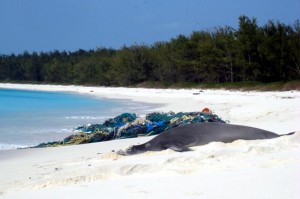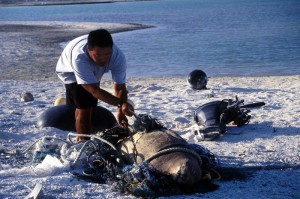Papahānaumokuākea Marine National Monument News Release, 25 April 2011

(Honolulu, HI) NOAA Ship Oscar Elton Sette returned to port at Ford Island/Pearl Harbor on April 22, 2011 after a multi-faceted mission to Papahānaumokuākea Marine National Monument in the Northwestern Hawaiian Islands. Directed by NOAA’s Pacific Islands Fisheries Science Center (PIFSC), one of the cruise’s primary goals was to establish five field camps and deploy 14 scientists with the Hawaiian Monk Seal Research Program (HMSRP). Over the course of the next three to four months the researchers will build upon 28 years of field research into the critically endangered Hawaiian monk seal. The population of Hawaiian monk seals is declining about 4% annually, driven largely by poor juvenile survival; with fewer than 1 in 5 pups surviving to become adults in the Northwestern Hawaiian Islands.
Dr. Charles Littnan, the Chief Scientist for HMSRP explained the field research camps help direct mitigation efforts to increase the survival of seals. Currently there are an estimated 1100 Hawaiian monk seals, with the majority of them in Papahānaumokuākea. Littnan said, “Our field camps have created one of the premiere population data sets for a species anywhere which allows us to understand the causes of mortality and develop strategies to increase monk seal survival.”
Monk seal field camps are located on five islands in Papahānaumokuākea: Laysan, French Frigate Shoals, Lisianski, Pearl & Hermes Atoll, and Kure Atoll. Some camps work on specific projects, aimed at enhancing monk seal survival rates.

In addition to deploying people and equipment, field crews and personnel from the Oscar Elton Sette did extensive tsunami related clean-up and debris removal from camp sites on all five islands or atolls. At Kure Atoll, four PIFSC and Hawaii Department of Land and Natural Resources researchers rescued and freed a weaned Hawaiian monk seal pup that was caught in debris and was in danger of drowning. At Lisianski Island, crews monitored several seals with injuries that may have been a result of the March tsunami generated by a major earthquake off of Japan. At each of the camps, scientists are attempting to determine if the tsunami caused increased Hawaiian monk seal mortality.
A known continuing entanglement threat to monk seals, turtles, and fragile coral reefs is marine debris. The Oscar Elton Sette returned to port with more than 16 tons of derelict fishing nets and other gear. Since marine debris removal efforts in the Northwestern Hawaiian Islands began nearly 15 years ago, more than 775 tons of debris has been removed from the reefs and shores of Papahānaumokuākea. The majority of this debris has been used to create electricity on Oahu. Numerous NOAA Offices; including Papahānaumokuākea Marine National Monument, the Pacific Islands Fisheries Science Center and the Marine Debris Program, along with a host of other public and private partners, fund and support continuing efforts to remove marine debris from the Northwestern Hawaiian Islands.
Papahānaumokuākea is cooperatively managed to ensure ecological integrity and achieve strong, long-term protection and perpetuation of Northwestern Hawaiian Island ecosystems, Native Hawaiian culture, and heritage resources for current and future generations. Three co-trustees – the Department of Commerce, Department of the Interior, and State of Hawaii – joined by the Office of Hawaiian Affairs, protect this special place. Papahānaumokuākea Marine National Monument was inscribed as the first mixed (natural and cultural) UNESCO World Heritage Site in the United States in July 2010.
Source: Field Camps Again Established to Support Hawaiian Monk Seal Research and Recovery Scientists Working to Determine Tsunami Impacts, Papahānaumokuākea Marine National Monument, News Release, 25 April 2011.
